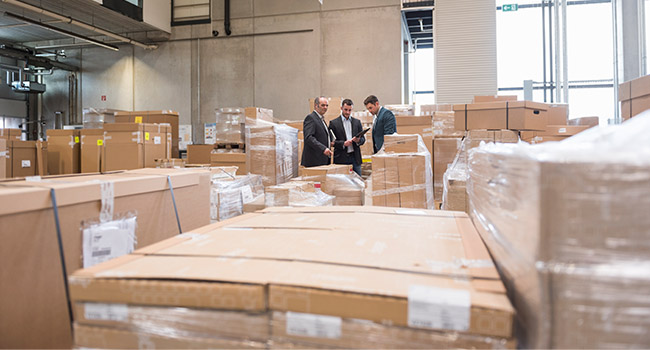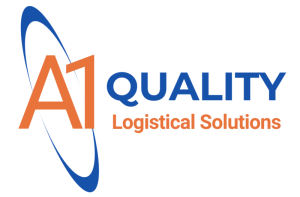A1 Quality Logistical Solutions

- By Haley
- November 14, 2024
Table of Contents
Key Highlights
- Outsourcing logistics to 3PL providers offers significant cost advantages for businesses of all sizes.
- 3PLs leverage economies of scale, technology, and expertise to optimize supply chain operations and reduce overall expenses.
- Businesses can realize cost savings in various areas, such as warehousing, transportation, and inventory management.
- Streamlined logistics processes, reduced overhead costs, and improved efficiency contribute to a healthier bottom line.
- Partnering with a 3PL allows businesses to focus on core competencies while benefiting from expert logistics management.
Introduction
This blog looks at why businesses are choosing third-party logistics (3PL) providers more and more. These providers help reduce costs and improve logistics operations, leading to significant cost savings.
Understanding the Role of 3PL in Modern Logistics
Third-party logistics (3PL) has changed the game in modern logistics. It alters how companies run their supply chain operations. 3PL providers are various businesses that focus on managing different logistics services for their clients. These logistics services can cover many activities, like:
- Transportation
- Warehousing
- Inventory management
- Order fulfillment
- Packaging
- Shipping and receiving
The main idea of 3PL is to outsource some or all logistics tasks to experts who can do them more effectively and at a lower cost. By letting these experts handle these tasks, companies can make their supply chains run smoother, reduce extra costs, and save helpful resources. This allows them to focus on their core competencies.

The Evolution of Third-Party Logistics Providers
The world of 3PL (third-party logistics) has morphed from its simple start as just freight forwarding. At first, these companies mainly helped move goods between businesses and transportation providers. As international trade grew, so did the need for better transportation services, which made many 3PL providers add more services.
Now, the 3PL sector has turned into a complex network of logistics companies that offer a wide range of services, such as:
- Warehousing and distribution
- Inventory management
- Order fulfillment
- Transportation management
- Reverse logistics
This change shows how complex global supply chains have become. Businesses need to optimize their logistics operations to save time and money. New tools like transportation management systems (TMS), warehouse management systems (WMS), and data analytics help 3PL providers improve visibility, control, and efficiency throughout the entire supply chain.
Core Services Offered by 3PL Providers
3PL providers are key partners for businesses that want to improve their supply chains. They focus on many important services including order fulfillment. Here, 3PLs use special fulfillment centers. These centers take care of the whole process of receiving, processing, packing, and shipping orders for their clients.
Another important part of 3PL services is efficient inventory management. 3PL providers use advanced inventory systems to help businesses manage their stock levels. This helps lower costs and reduces the chances of running out of stock or having too much. By predicting demand correctly and tracking inventory in real time, 3PLs allow businesses to keep their supply chains sleek and responsive.
In addition to warehousing and fulfillment, 3PLs also offer great shipping services. They work out good rates with carriers, combine shipments to save money, and handle the entire shipping process from pickup to delivery. Using their skills and connections, 3PLs guarantee quick and affordable shipping, whether by land, air, or sea. They also provide real-time tracking so businesses can see where their shipments are at all times.
Why Businesses Are Turning to 3PL Providers
When businesses choose to work with 3PL providers, they can simplify their operations, cut costs, and focus more on what they do best. 3PL providers offer a lot of experience, knowledge, and resources. They can manage logistics operations better than in-house teams. This helps reduce transportation costs and improve inventory management. It also leads to better order fulfillment processes.

Cost-Effective Solutions for Logistics Management
Instead of companies dealing with the hard work of negotiating rates with carriers or managing transportation logistics by themselves, 3PLs use their industry knowledge, good relationships with carriers, and advanced management software. This helps them get better shipping rates and ensure fast transportation routes. As a result, businesses see lower transportation costs and can use that money to invest in other areas.
Another way for cost savings is utilizing 3PLs’ skills in warehousing and inventory management. 3PLs have a wide network of warehouses to help companies lower storage costs, cut down stockholding time, and speed up delivery to customers. By using resources efficiently, along with their expertise in demand forecasting and inventory control, 3PLs can reduce warehousing costs, leading to more savings for businesses.
Enhancing Efficiency and Flexibility in Supply Chain
3PL providers play a key role in improving a company’s supply chain flexibility. This flexibility is crucial in today’s changing market. Businesses need to respond quickly to shifts in demand, changing customer preferences, and sudden disruptions. 3PLs help with this flexibility through a variable cost model. This means companies can adjust their logistics operations based on their needs without the burden of fixed costs from keeping their own warehouse or transportation fleet.
This ability to scale helps manage busy seasons and unexpected spikes in demand. This way, companies can meet what customers want without spending too much. In addition, 3PLs have a wide network of warehouses and transport partners. This gives businesses the chance to expand into new regions easily, without needing to set up their own locations. This quick response to market changes helps companies grow and stay ahead of the competition.
Also, 3PLs use advanced technology and real-time data analytics. This improves supply chain visibility and helps companies make better decisions. When businesses have a clear view of the entire supply chain, from purchasing to delivery, they can spot issues, predict disruptions, and adjust their plans quickly. This mix of flexibility, technology, and know-how from 3PLs helps businesses deal with the challenges of today’s supply chains more effectively.
Comparing In-House Logistics and 3PL Providers
The choice to manage logistics operations in-house or to use a 3PL provider is layered. This decision affects how a business works, its costs, and its overall success. Handling logistics internally can be appealing as it offers more control and possible cost savings. On the flipside, it can also come with hidden costs and complicated issues. This is especially true for fast-growing companies or those with complex supply chains.
Overall, working with a 3PL provider helps businesses use expert knowledge, lower costs through shared resources, and better technology. When deciding, you should carefully weigh both options. Look at the pros and cons to find the best choice for your business needs and future goals.

Analyzing the Cost Implications
When comparing the cost implications of in-house logistics versus outsourcing to a 3PL provider, it’s easy to focus solely on the upfront expenses. However, a comprehensive analysis requires a more nuanced approach that considers both direct and indirect costs associated with each option. While managing logistics in-house might seem initially appealing for having greater control over operations, this approach often entails hidden costs that can quickly add up.
Businesses must consider expenses related to:
- Warehousing
- Transportation
- Technology
- Staffing
- Training
- Insurance
These costs can fluctuate significantly depending on factors like:
- Inventory levels
- Shipping costs
- Fuel prices
- Labor market conditions
On the other hand, 3PL providers offer the advantage of economies of scale, allowing them to leverage their extensive network and negotiate favorable rates for transportation, warehousing, and other logistics operations. Additionally, outsourcing logistics eliminates the overhead associated with managing these functions in-house, freeing up valuable capital for investment in core business activities.
|
Cost Component |
In-House Logistics |
3PL Provider |
|
Warehousing |
Fixed costs: Rent/mortgage, utilities, maintenance |
Variable costs: Based on space utilization, services used |
|
Transportation |
Fixed costs: Vehicle fleet, maintenance, insurance |
Variable costs: Based on shipping volume, distance, carrier rates |
|
Technology |
High upfront costs: Software, hardware, implementation |
Lower costs: Access to shared technology platform, economies of scale |
|
Staffing |
Fixed costs: Salaries, benefits, training |
Variable costs: Based on services used, volume fluctuations |
By partnering with a 3PL provider, businesses benefit from having a single point of contact for all their logistics needs, simplifying operations and allowing for better cost control.
The Impact on Operational Efficiency
Examining how in-house logistics and 3PL providers affect operational efficiency shows big differences. In-house logistics can be tough for businesses that are growing fast or dealing with complicated supply chains. They might use too many internal resources and take attention away from key business tasks. Keeping enough staff, dealing with changing inventory, and ensuring deliveries happen on time can put a lot of stress on internal teams. This often leads to problems like delays and higher costs.
On the other hand, 3PL providers are experts at logistics. They have the skills, the systems, and the tools needed to make every part of the logistics process better. With teams focused on warehousing, transportation, and order fulfillment, they can help businesses streamline their operations. This means less handling time and fewer mistakes. They also use advanced technology for inventory management, order tracking, and route planning. This way, 3PLs can improve efficiency and give their clients real-time insights into their supply chain.
Additionally, 3PL providers keep putting money into their processes and technology. This means their clients can enjoy the latest in logistics management. By improving their services, 3PLs help businesses make supply chains smoother, reduce lead times, boost delivery accuracy, and reach higher operational efficiency. Working with a 3PL gives businesses an edge. It allows them to deal with the complex logistics while they focus on growing their core business.
The Financial Benefits of Outsourcing Logistics
Outsourcing logistics to 3PL providers can bring strong financial benefits, mainly through cost savings. One big reason for these savings is shifting from fixed costs of having in-house logistics to more flexible variable costs offered by 3PLs. By outsourcing, businesses no longer need to spend a lot on:
- Warehouses
- Transportation fleets
- Technology infrastructure
Instead, they only pay for the services they use, based on what they need at the time. This flexibility helps businesses adjust their logistics operations to meet seasonal demand, market changes, or growth in their business without dealing with fixed costs that can hurt profits in slower times.
Additionally, 3PL providers can save clients money because of their economies of scale. They handle large amounts of work and have good relationships with carriers and suppliers. This allows 3PLs to get better rates for transportation, warehousing, and other logistics services, which they pass on to their clients. These savings, along with their skills in improving logistics operations, help businesses have a better bottom line. This leaves them more resources to invest back in core competencies, research and development, or expanding into new markets.

Reduction in Capital Expenditure
One big financial benefit of using 3PL providers is the large drop in capital expenditure that companies see. Building and keeping a strong in-house logistics system needs a lot of upfront money. These costs often include:
- Buying or renting warehouse spaces
- Creating a fleet of trucks or other transportation vehicles
- Using complex logistics management software
These expenses can put a strain on a company’s finances, especially for new or growing businesses. Hiring a 3PL removes the need for these costly investments. Since 3PLs already have a wide network of warehouses and transport options, businesses can use this setup without facing the high costs that come with creating and managing it themselves.
Besides the initial costs, 3PLs take care of ongoing expenses for warehouse operations, managing transportation, and updating technology. By spreading these costs among their many clients, 3PLs allow businesses to access high-quality logistics services for much less than it would cost to do it themselves. Moreover, 3PLs are skilled in reverse logistics, which can bring in more savings. By improving how returns are handled, reducing waste, and possibly getting value from returned goods, 3PLs help make a more sustainable and cost-effective supply chain.
Variable vs Fixed Cost Structures
Understanding how variable and fixed cost structures work is very important when looking at the financial effects of outsourcing logistics to 3PL providers. In-house logistics usually have more fixed costs. These costs do not change much based on business volume and include expenses like:
- Rent or mortgage payments for warehouse space
- Salaries and benefits for logistics staff
- Depreciation of transportation assets
This fixed cost setup can be tough, especially for businesses with changing demand or seasonal sales. When there isn’t much activity, fixed costs keep rising, which can hurt profit margins. On the other hand, 3PL providers give a more flexible, variable cost structure.
With a variable cost model, businesses pay for the logistics services they use. This allows them to adjust their logistics operations based on changes in demand. This pay-as-you-go method ties costs closely to revenue. It makes sure businesses only pay for the resources they need at any time. The variable cost setup offered by 3PLs is especially helpful for:
- Startups and small businesses that don’t have money to invest in fixed logistics structures
- Companies with seasonal sales or changes in demand, where flexibility matters
- Businesses that want to grow into new markets without spending a lot of money upfront
By moving from a fixed to a variable cost business model through outsourcing, businesses can make their cost structures better, boost financial efficiency, and improve overall profit.
How 3PL Providers Drive Cost Savings
3PL providers help their clients save money by using their knowledge, big networks, and tech skills. One main way they do this is by cutting transportation costs, which can be a large expense for companies. They save money by combining shipments, getting discounts from carriers, and using smart route planning software. These savings go back to their clients.
Also, 3PL providers are good at warehousing and inventory management. This helps lower storage costs and makes sure orders are completed on time. They use demand forecasting, control inventory, and choose the best places for warehouses. This way, businesses keep the right amount of stock, waste less, and avoid the problems of running out of products or having too much.

Economies of Scale and Negotiating Power
The idea of economies of scale is key to how 3PLs can save money for their clients. By sharing resources and managing logistics for many businesses, 3PLs get big discounts on important services like:
- Transportation
- Warehousing
- Packaging
These economies of scale help 3PLs provide their services at a lower cost per item than what most businesses can do on their own. This is especially true for small and medium-sized businesses that do not have enough volume to get good prices from carriers and suppliers.
In addition to economies of scale, 3PLs have a lot of negotiating power because of their strong connections with many carriers and suppliers. This leverage helps them to get better rates for transportation, warehousing, and other logistics services. These lower rates lead to big cost savings for their clients.
On the other hand, a freight forwarder mainly focuses on moving goods but usually does not have the full setup or skills to cut costs all through the entire supply chain. By grouping shipments from different clients, 3PLs can boost their negotiating power even more and reduce transportation costs.
Advanced Technologies and Systems for Efficient Operations
Embracing advanced technology helps successful 3PL providers stand out from traditional logistics. This allows them to be more efficient and save costs. 3PLs put a lot of money into the best warehouse management software (WMS) to improve all parts of warehouse work, including:
- Inventory tracking and control
- Order picking and packing
- Labor management
- Shipping and receiving
By automating tasks, arranging the warehouse to be more effective, and giving real-time updates on inventory, WMS helps cut errors. It also lowers lead times and makes better use of space, which saves businesses a lot of money.
In addition, 3PLs use their advanced transportation management systems (TMS) to improve their shipping strategy. These systems use smart algorithms and real-time data to find the cheapest routes for transporting goods. They look at things like:
- Distance
- Fuel costs
- Delivery time windows
- Carrier capacity
By planning and sending shipments more effectively, TMS software helps lower transportation costs, speed up delivery times, and make the supply chain work better. Many 3PLs also connect their systems with their clients’ e-commerce platforms. This makes order processing easy, allows for real-time order tracking, and ensures automated communication with customers, all of which help improve efficiency and customer satisfaction.
Strategic Advantages of Partnering with a 3PL Provider
Partnering with a 3PL provider gives businesses many benefits beyond just cost savings. This help can improve how they work, boost their competitiveness, and support long-term growth. One main advantage is that businesses can focus on core competencies. When they hire a service provider for logistics and other non-core jobs, they can save important time, money, and staff. This lets them concentrate on what they do best, like creating new products or services, building better customer relationships, reaching new markets, or making their internal processes better. When they focus more on their main activities, they can become more efficient, more innovative, and grow faster.
Another big advantage of working with a 3PL is getting the provider’s global market expertise. Global 3PLs know a lot about:
- International trade rules
- Customs processes
- Transportation systems
- Cultural differences
Using this knowledge is very helpful for businesses aiming to grow in international markets. 3PLs ensure that businesses follow local rules, handle cultural differences smoothly, and gain an upper hand when entering new markets.

Focusing on Core Business Competencies
In a business world full of tough competition and changing customer needs, companies must focus on their core competencies. These are the strengths that make them different from their competitors and add value for their customers. If a company tries to handle everything in-house, including things like logistics, it can waste time, money, and effort. This can lead to missed chances, slower growth, and becoming less competitive.
By outsourcing logistics to a specialized 3PL provider, business owners can pay attention to what really matters. This includes improving their products or services, making customer experiences better, and encouraging innovation. This change helps businesses use their resources and knowledge in areas where they can compete best. For example, a fast-growing e-commerce company might outsource its fulfillment and shipping. This lets the business owner and their team focus on product development, marketing, and customer service.
Making this choice allows the company to grow quickly without getting stuck in the problems of running a complicated logistics system. This leads to better efficiency, faster growth, and a stronger position in the market.
Access to Global Market Expertise
Expanding into global markets offers great chances for businesses. It allows them to reach more customers and grow significantly. However, dealing with international trade can be hard. It needs a good understanding of:
- Foreign regulations
- Customs procedures
- Logistics networks
Working with a 3PL that has strong global market expertise can really help. 3PLs know how to handle the challenges of international distribution services. They ensure that products move smoothly across borders while following local rules and customs requirements. By using their network of trusted partners and their knowledge of global trade, 3PLs make it easier to enter new markets.
Additionally, 3PLs provide useful insights into local market conditions. This includes learning about consumer behavior, competition, and new trends. This information helps businesses adapt their products or services to fit local tastes. It also aids in creating effective marketing campaigns and planning better strategies when entering new areas. 3PLs act as a support team for their clients, offering help and knowledge to handle global expansion.
Their understanding of local regulations, tariffs, and customs procedures helps businesses avoid expensive delays and problems. With their global market expertise and reliable logistics solutions, 3PLs enable businesses to confidently navigate international trade. This way, they can enter new markets and promote global growth.
Case Studies: Success Stories of 3PL Partnership
Many case studies show how good partnerships with 3PLs can change businesses in different industries. For example, a growing e-commerce retailer teamed up with a 3PL that focused on fulfillment and last-mile delivery. This helped them lower shipping costs, speed up delivery times, and improve customer satisfaction. This smart partnership let the retailer grow quickly without spending too much on warehouses and logistics. They could then concentrate on expanding their products and finding new customers.
In another strong example, a global manufacturing company worked with a 3PL to make their supply chain better. This led to lower inventory costs, improved production efficiency, and better visibility into their global operations. By using the 3PL’s skills in international transportation, customs, and warehouse management, the manufacturer made their supply chain smoother. They cut down lead times and boosted customer service, which helped them gain an edge in the global market.

E-commerce Businesses Leveraging 3PL for Growth
In the competitive world of e-commerce, having a smooth and efficient fulfillment process is very important for success. Many ecommerce businesses are choosing third-party logistics (3PL) providers. They do this to improve fulfillment, lower costs, and boost customer satisfaction. By outsourcing jobs like:
- Warehousing
- Order picking and packing
- Shipping
Ecommerce companies can focus more on what they do best, like product development, marketing, and gaining customers.
3PLs are experts at providing dependable and flexible fulfillment services to meet the unique needs of ecommerce businesses. They run advanced fulfillment centers that can quickly handle lots of orders accurately. These centers use technology, like warehouse management systems (WMS) and order tracking software, to make things efficient, reduce mistakes, and show real-time updates on fulfillment.
Also, 3PLs usually have good connections with many carriers. This helps them get better shipping rates and give ecommerce businesses choices for shipping, like same-day, next-day, and international delivery. This flexibility lets ecommerce businesses meet the growing demand from online shoppers for fast and low-cost shipping, which boosts customer satisfaction and builds loyalty.
Manufacturing Sector and the Integration of 3PL Services
The manufacturing sector needs a smooth supply chain to get raw materials, parts, and finished products on time. More businesses are using 3PL services to make their logistics better and cut costs. One big benefit of working with 3PLs is better supply chain visibility. They use modern tracking tools and data analysis to give real-time updates on where goods are in the supply chain.
With a clear view of inventory levels, delivery routes, and schedules, manufacturers can spot delays early. This helps them improve production plans and ensure products reach customers on time, keeping them happy. Additionally, 3PLs make it easier for manufacturers by placing distribution centers in good locations to lower transportation costs and delivery times.
They also use smart warehouse management methods, like just-in-time (JIT) inventory management and cross-docking. This helps to cut storage costs and speed up goods flow. By managing inventory better and improving distribution, 3PLs help manufacturers lower logistics costs, boost operational speed, and handle market changes more successfully.
Selecting the Right 3PL Partner
Choosing the right 3PL partner can greatly affect your business’s supply chain efficiency, costs, and overall success. There isn’t a single right choice for everyone. You need to think about factors like industry experience, growth potential, technology, and how well they fit with your company culture, in addition to cost. It is important to know your specific needs and long-term goals to find a 3PL that matches your business objectives.
Make sure to understand the 3PL’s strengths and weaknesses. Look at their experience in your industry and their technology skills. Also, check how they handle customer service. A careful selection process with evaluation, research, and clear communication will help create a successful and beneficial partnership.

Key Considerations for Choosing a 3PL Provider
When choosing a 3PL provider, you must think about a few key things to make sure they fit with your logistics needs, business goals, and plans for growth. Start by setting clear selection criteria. This will help you narrow down your choices and find a 3PL that can meet your requirements.
Look at your current and future logistics needs. Consider factors like order volume, shipping areas, inventory management complexity, and any special needs, like cold storage or handling dangerous materials. Then, check the experience and skills of the potential 3PL providers in your industry. Each industry has different logistics challenges and rules. So, it’s crucial to choose a 3PL that knows your sector well. Look at their past work, client reviews, and case studies to see how they can handle your logistics needs.
Technology is very important in today’s logistics. Make sure to evaluate the 3PL’s technological abilities as well. Ask yourself:
- Do they provide real-time order tracking and visibility?
- Do they use advanced warehouse management systems and transportation management systems to improve operations and get useful data insights?
Also, ask about their security measures to keep your valuable inventory and customer data safe. Check their cybersecurity policies, insurance coverage, and how they comply with industry standards.
Evaluating 3PL Providers: A Checklist
Creating a complete evaluation checklist is the first step when looking for potential 3PL providers. This helps you choose a partner that fits your business needs and goals. Your checklist should cover key areas in the 3PL’s operations, abilities, and performance. Start by looking at their experience and skills in your industry. Check their history, client list, and industry certifications.
Next, check their network, including where their warehouse locations are, transportation hubs, and how far they can reach globally. Think about how close their facilities are to your main markets and if they can handle your shipping volume and destinations. Technology plays a big role in logistics today, so look closely at the 3PL’s technology. This includes their:
- Warehouse management system (WMS)
- Transportation management system (TMS)
- Order tracking capabilities
Also, assess the 3PL’s customer service and communication.
- Do they give you a dedicated account manager who understands your needs?
- Are they quick to reply to questions and fix issues?
- Knowing how they communicate and serve customers tells you a lot about their focus on client satisfaction.
Lastly, take a close look at the 3PL’s pricing, contract terms, and performance guarantees. Ask for clear proposals that explain their services, fees, and key performance indicators (KPIs). Compare the pricing options, contract flexibility, and performance guarantees to make sure they match your budget and goals.
The Future of 3PL in Logistics Management
As the world becomes more connected and complex, the 3PL industry is expected to keep growing and changing. This growth is happening because of new customer needs and fast changes in technology in logistics. Future trends show a rising need for 3PL providers who can give:
- Complete supply chain solutions
- Advanced technology skills
- Global service ability
There is also movement toward more specialized services. This means that 3PLs may focus on certain industries or unique services, like cold chain logistics for drugs or omnichannel help for online shopping.
Moreover, new technologies such as artificial intelligence (AI), blockchain, and the Internet of Things (IoT) will likely change the 3PL scene even more. AI-driven tools will help businesses forecast demand better and optimize their inventory. Blockchain can improve supply chain clarity and tracking. The growing use of robots and automation in warehouses will boost efficiency and decrease the need for manual work. 3PL providers who accept these tech trends and adjust their services will be ready to succeed in the fast-changing world of supply chain management.

Trends Shaping the 3PL Industry
In the last few years, the 3PL industry has seen big changes. These changes are changing how logistics providers work. One key change is the use of advanced technology. This includes tools like transportation management systems and warehouse management software. These tools help improve efficiency and give better visibility into the supply chain.
There is also a growing demand for cost-effective solutions. Because of this, many businesses are choosing to create strong partnerships with third-party logistics providers. These partnerships help make logistics processes smoother. They also help lower shipping costs. In the end, this improves the bottom line for companies that want to outsource their supply chain operations.
The Role of Technology in Enhancing 3PL Services
By using modern management software and transportation management systems, logistics providers can improve how they operate. They can plan routes better and see the supply chain clearly. Advanced technology helps track shipments in real time. This makes customers happy because they can see where their goods are. When warehouse management systems are used, inventory accuracy goes up, which reduces mistakes in order processing. Overall, technology helps 3PL providers give great services. This ensures maximum efficiency and cost savings for businesses.
Conclusion
Outsourcing logistics to third-party providers has many benefits. It can save costs and make supply chain operations smoother. Businesses can focus on their core competencies while letting experts handle logistics. This leads to better efficiency and lower shipping costs. It also helps boost customer satisfaction. Using third-party logistics is a smart choice. It allows companies to adapt to market conditions better and improve their bottom line.
Frequently Asked Questions
What Are the Signs That Your Business Needs a 3PL Provider?
If you have trouble managing inventory, are dealing with delivery delays, or don’t have enough knowledge in logistics, it might be a good idea to think about outsourcing to a 3PL provider. Watch for these signs to see if your business could use their help.
How can outsourcing logistics help in reducing operational costs?
Outsourcing logistics reduces operational costs by leveraging 3PL expertise and economies of scale, leading to cost-effective solutions and enhanced efficiency in supply chains. This strategic move allows businesses to focus on core competencies while benefiting from a global market perspective.

Haley serves as the Marketing Manager for A1 Quality Logistical Solutions. She joined A1QLS in 2023 with her prior experience gained with GXO and XPO Logistics.
